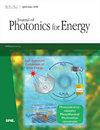钙钛矿光伏电池横向分光系统
IF 2.1
4区 工程技术
Q4 MATERIALS SCIENCE, MULTIDISCIPLINARY
引用次数: 2
摘要
摘要我们研究了具有钙钛矿光伏电池的多结光谱分裂光伏(PV)太阳能系统的潜力。光谱分裂允许横向分离的不同能带隙PV电池的组合,并避免了制造串联堆叠结构的复杂性。体全息光学元件已被证明对光谱分裂操作是有效的,并且可以被结合到紧凑的模块封装中。然而,频谱分割系统的剩余问题之一是实现高整体转换效率所需的低成本宽带隙和中频隙单元的可用性。钙钛矿光伏电池已被制造成具有广泛的带隙能量,这些带隙能量可能满足多结光谱分裂系统的要求。对能带隙分别为2.30、1.63和1.25eV,转换效率分别为10.4%、21.6%和20.4%的钙钛矿光伏电池组合的光谱分裂系统进行了评估,这已在文献中得到实验证明。首先,设计了一种级联体全息透镜,用于三个光谱带的光谱分离。其次,建立了计算级联全息图衍射效率的严格耦合波模型。该模型考虑了上全息图和下全息图中较高衍射级之间的交叉耦合,以前的模型没有考虑到这一点,但在实验验证中也包括了这一点。最后,分析了系统中的光学损耗,计算出假设的功率转换效率为26.7%。本文章由计算机程序翻译,如有差异,请以英文原文为准。
Lateral spectrum splitting system with perovskite photovoltaic cells
Abstract. We examine the potential of a multijunction spectrum-splitting photovoltaic (PV) solar energy system with perovskite PV cells. Spectrum splitting allows combinations of different energy band gap PV cells that are laterally separated and avoids the complications of fabricating tandem stack architectures. Volume holographic optical elements have been shown to be effective for the spectrum-splitting operation and can be incorporated into compact module packages. However, one of the remaining issues for spectrum splitting systems is the availability of low-cost wide band gap and intermediate band gap cells that are required for realizing high overall conversion efficiency. Perovskite PV cells have been fabricated with a wide range of band gap energies that potentially satisfy the requirements for multijunction spectrum-splitting systems. A spectrum-splitting system is evaluated for a combination of perovskite PV cells with energy band gaps of 2.30, 1.63, and 1.25 eV and with conversion efficiencies of 10.4%, 21.6%, and 20.4%, respectively, which have been demonstrated experimentally in the literature. First, the design of a cascaded volume holographic lens for spectral separation in three spectral bands is presented. Second, a rigorous coupled wave model is developed for computing the diffraction efficiency of a cascaded hologram. The model accounts for cross-coupling between higher diffraction orders in the upper and lower holograms, which previous models have not accounted for but is included here with the experimental verification. Lastly, the optical losses in the system are analyzed and the hypothetical power conversion efficiency is calculated to be 26.7%.
求助全文
通过发布文献求助,成功后即可免费获取论文全文。
去求助
来源期刊

Journal of Photonics for Energy
MATERIALS SCIENCE, MULTIDISCIPLINARY-OPTICS
CiteScore
3.20
自引率
5.90%
发文量
28
审稿时长
>12 weeks
期刊介绍:
The Journal of Photonics for Energy publishes peer-reviewed papers covering fundamental and applied research areas focused on the applications of photonics for renewable energy harvesting, conversion, storage, distribution, monitoring, consumption, and efficient usage.
 求助内容:
求助内容: 应助结果提醒方式:
应助结果提醒方式:


